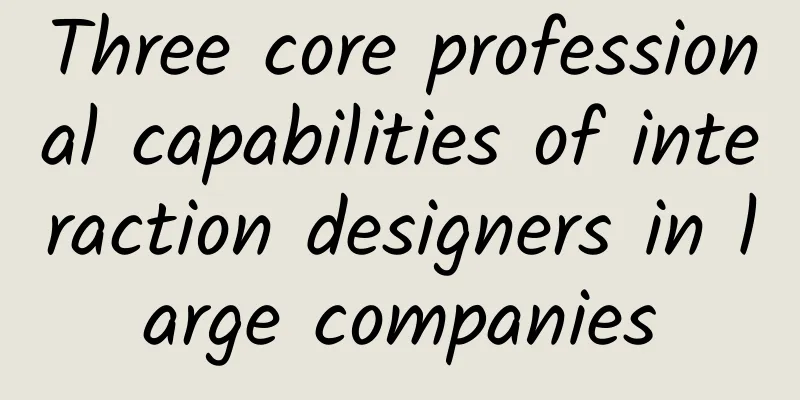Three core professional capabilities of interaction designers in large companies

|
For nearly a year and a half, I have been thinking about what are the core capabilities of design? What capabilities determine whether an interaction designer is good?
I have summarized the following three core capabilities that excellent interaction designers need to possess:
Professional capabilitiesProfessional ability refers to the ability that designers need to have in their work. The stronger the ability, the easier it is to gain recognition from upstream and downstream. For interaction designers, professional ability is the specific embodiment of business ability. Professional ability includes the following aspects: 1. Aesthetics There is no quantifiable standard for aesthetics, but there is indeed a difference in aesthetics. People with low aesthetics cannot see the ugliness of their own drawings, but people with high aesthetics can tell at once that the drawings are not well made. Therefore, the quality of drawings made by people with high aesthetics is generally good. Aesthetics is not innate, it is acquired. The more you look at pictures, the faster your aesthetics will improve. This is a process of accumulation over time, and there is no quick fix. Because it is impossible to learn quickly, this is also the reason why it is difficult for people with zero foundation to do good design after graduating from a training course, because their aesthetic taste is difficult to improve all at once. They don’t think the pictures they make are ugly, but in the eyes of designers with high aesthetic taste, they cannot be used. Interaction designers need relatively high aesthetic ability to make high-quality interaction drafts at work. 2. Efficiency of drawing Drawing efficiency is very important, especially when facing multiple businesses and multiple demands. Drawing efficiency is one of the most important capabilities of a designer. In the same period of time, the higher the output of an interaction designer, the more obvious his advantage in the team. The way to improve drawing efficiency is to set a final node for yourself and constantly squeeze the time for the final node. After half a year of training, drawing efficiency can be greatly improved. 3. Interaction details and process The contrast between important and non-important information in the interactive interface is obvious, and the hierarchical relationship is clear. On the basis of meeting product and business goals, the simpler and easier to understand the interactive process design is, the more it conforms to the user's usage cognition, and the smoother the user's use will be. 4. No logical problems The interactive draft produced by a professional interactive designer must not have logic problems. If there are logic problems, it means that there are major omissions in the interactive draft, which is the dereliction of duty of the interactive designer, so logical problems should be avoided as much as possible. 5. Design Methodology Many designers are easily at a loss after receiving product requirements. They don't know how to start. At most, they look at related competing products, learn from their ideas and solutions, and then start designing. In this case, designers lack independent thinking ability and design deduction. Are there any ways to allow designers to make design solutions that suit them? There are five commonly used design methods: breaking down design requirements, analyzing online data, exhausting design solutions, switching user perspectives, and comparing competing solutions. Propulsion capabilityDriving ability refers to the designer's ability to follow up and promote the project throughout the entire collaborative process. Excellent designers should have good driving ability. Scenario 1: At the interaction review meeting, the product manager said that XX also has such a design, so we can just follow XX's design and there is no need to design it like you; the developer said that such a design is relatively expensive and it is not recommended to use this solution; the operator said that such a design is not attractive enough to users and it can be changed to this... After one review, everything from the user flow to the interface layout was changed beyond recognition. What’s even more frightening is that at the next review meeting to confirm the interaction, the consensus reached before was overturned again, falling into a vicious cycle… Scenario 2: The product manager gives you a rough prototype diagram and asks you to complete the prototype process and details...; The interaction review is finally passed and given to the visual designer to make a visual draft. The visual designer adds his own ideas and modifies the structural logic definition rules of your interaction draft according to his own understanding of the logic... The above two scenarios may be encountered by many interaction designers. In the above two scenarios, the role of interaction designers is completely passive, reduced to a miserable wireframe guy, and has nothing to do with the promoter of design. So the question is how can interaction designers change from passive to active and become a promoter of design? The root cause of the above two scenarios is that interaction designers lack professional ability, aura and communication skills in their daily work. Because of the lack of these, they have a low status at work, are constantly questioned and modified, and have difficulties in connecting with various roles. Professional ability, aura and communication skills cannot be improved in a short period of time, but there are routines to deal with scenarios 1 and 2. Scenario 1: Learn to split usage scenarios and describe interaction solutions during the review process Interaction designers who directly use specific interactive prototype interfaces for review are easily questioned and overturned. People in the meeting are very sensitive to specific interfaces. Learn to use abstract things for review, which can attract most of the attention of people in the meeting, and finally come up with a specific interactive prototype interface. The entire interactive prototype can be divided into many pages. First, explain the background of the entire design (business background, technical background), the applicable population, and the problems solved by the entire interactive design. Then talk about the needs, split the needs, split different usage scenarios and corresponding functional flow charts. Basically, in this process, other people in the meeting will not have too many objections, because this is abstract and not easy to refute. This process is basically a one-shot process. Finally, the corresponding scenes, functional flow charts and the final interactive prototypes are matched one by one. Most of the time and energy in the previous stage is used to lay the foundation for the final interactive prototype, so that the interaction can be passed in one draft. Scenario 2: When you are communicating with the product and vision privately, you should try to reach an agreement with the other party, stand on a united front, and help them share the pressure. At the same time, you can achieve the desired results through external factors. Take charge of the prototype output document work for the product manager. Let the product manager realize that I am more professional and worry-free in making interactive prototypes, and he does not need to distract his energy on this. He can spend more time controlling the progress of product requirements and exploring needs. Let him realize that I am his close comrade-in-arms, and we can solve product problems together. The relationship with the visual designer is a user experience team. When encountering disagreements, you can persuade the other party from multiple angles such as product, development, and users. If you encounter a really paranoid visual design who forcibly changes the prototype determined by the interactive review beyond recognition, you can discuss the visual draft at the review meeting, let the visual designer accept the challenges of the roles of product manager, development, operation, etc., and after a few rounds, the visual designer will not change the logic and overall layout of the interactive prototype. Innovation1. Design innovation Have the ability to innovate in design and not be bound by existing design solutions on the market. Some designers do not have any solutions in mind after receiving the requirements. They first look at competing products, then refer to competing products and make similar solutions. The whole design process lacks creativity. After receiving the requirements, an excellent interaction designer will have at least three solutions in mind, and then analyze the advantages and disadvantages of each solution to find the most suitable one. He can even come up with more innovative solutions that are feasible and can enhance the design value of the current requirements. 2. Problem-solving innovation Problems encountered at work can be solved in a better way, which tests the emotional intelligence of interaction designers. Designers with high emotional intelligence can satisfy each role and promote the implementation of the design. How to innovatively solve the difficulties in work is a very important skill for designers. A common approach is to work with other roles to solve the problem. After completing the task, learn to review and constantly summarize the problems in the process to facilitate subsequent optimization. The above are the three core capabilities of interaction designers. If you have other insights, please leave a message in the comment area. |
<<: WeChat is updated again: We can now browse Moments on the computer
>>: The last line of defense! Five steps to improve UI interaction acceptance efficiency
Recommend
Half of Americans refuse to buy fully self-driving cars, and the safety of self-driving cars is causing anxiety
Recently, a new survey by foreign media found tha...
A frog draws for a week: Get to know the "magic brush Ma Liang" in the Institute of Biology
Author: Yang Chen In the days when there were no ...
Commonly rejected advertising materials and coping skills!
In daily work, I often hear the cries of operatio...
Changba: How to discover, support, produce and retain users?
The mobile KTV application Changba has been in op...
The advertising volume is not ideal? Facebook advertising optimization in practice!
There are thousands of problems with advertising,...
If porting doesn't make a TV game a success, why not learn from Steam's innovative gameplay?
Android TV game, this term has long become a shor...
Startup products: How to scale up offline?
Recently, I have been learning how startups can s...
Are you also dominated by "battery health phobia"? Please click on the "correct way" to charge
In today's information age, computers and mob...
The home appliance market once again ushered in a new turning point in the business war
Everything will be reset to zero. With the openin...
Techniques and strategies for Weibo promotion and traffic generation
Weibo is a platform with huge traffic, with two s...
Foreign media: Huawei is preparing to release its own mobile operating system
For Huawei, Google's move means that they can...
Weekly crooked review | IT circles are full of scheming! Qiangdong welcomes a child, and Jack Ma gives another gift
What is a crooked review? If it is not right, it ...
Dark Horse Prince April 2021 Peking University Boya Wave Practical Training Class
Dark Horse Prince April 2021 Peking University Bo...
AI can read people's minds! How long can you keep your little secrets secret?
Audit expert: Zheng Yuanpan Professor of Zhengzho...









